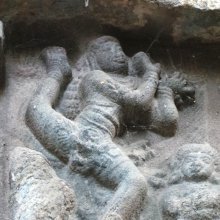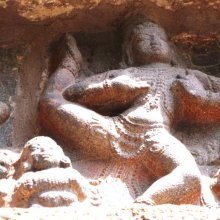Harinapluta, Hariṇapluta, Harina-pluta: 9 definitions
Introduction:
Harinapluta means something in Hinduism, Sanskrit. If you want to know the exact meaning, history, etymology or English translation of this term then check out the descriptions on this page. Add your comment or reference to a book if you want to contribute to this summary article.
Images (photo gallery)
In Hinduism
Natyashastra (theatrics and dramaturgy)
Source: Wisdom Library: Nāṭya-śāstra1) Hariṇapluta (हरिणप्लुत).—One of the 108 karaṇas (minor dance movement) mentioned in the Nāṭyaśāstra chapter 4. The instructions for this hariṇapluta-karaṇa is as follows, “after observing the Atikrāntā Cārī one jumps and stops, and then one of the shanks are bent and thrown up.”.
A karaṇa represents a minor dance movements and combines sthāna (standing position), cārī (foot and leg movement) and nṛttahasta (hands in dancing position).
2) Hariṇaplutā (हरिणप्लुता) refers to a one of the thirty-two cārīs, according to the Nāṭyaśāstra chapter 11. The Hariṇaplutā-cārī is classified as a ākāśikī, or “aerial”, of which there are sixteen in total. The term cārī refers to a “dance-step” and refers to the simultaneous movement of the feet (pāda), shanks (jaṅghā) and the hip (ūru). From these cārīs proceed dance as well as movements in general.
3) Hariṇaplutā (हरिणप्लुता) refers to a type of syllabic metre (vṛtta), according to the Nāṭyaśāstra chapter 16. In this metre, the fourth, the seventh, the tenth and the twelfth syllables of a foot (pāda) are heavy (guru), while the rest of the syllables are light (laghu). It is also known by the name Drutavilambita.
⏑⏑⏑¦⎼⏑⏑¦⎼⏑⏑¦⎼⏑⎼¦¦⏑⏑⏑¦⎼⏑⏑¦⎼⏑⏑¦⎼⏑⎼¦¦
⏑⏑⏑¦⎼⏑⏑¦⎼⏑⏑¦⎼⏑⎼¦¦⏑⏑⏑¦⎼⏑⏑¦⎼⏑⏑¦⎼⏑⎼¦¦
Hariṇaplutā falls in the Jagatī class of chandas (rhythm-type), which implies that verses constructed with this metre have four pādas (‘foot’ or ‘quarter-verse’) containing twelve syllables each.
Source: archive.org: Natya ShastraHariṇaplutā (हरिणप्लुता).—A type of aerial (ākāśikī) dance-step (cārī);—Instructions: the foot in the Atikrāntā Cārī to be caused to fall on the ground after a jump, and the shank of an Añcita foot to be put in the Kṣipta posture.
Source: Shodhganga: Elements of Art and Architecture in the Trtiyakhanda of the Visnudharmottarapurana (natya)Hariṇapluta (हरिणप्लुत) refers to one of the 108 kinds of Karaṇa (“coordination of precise movements of legs and hands”), according to the Viṣṇudharmottarapurāṇa, an ancient Sanskrit text which (being encyclopedic in nature) deals with a variety of cultural topics such as arts, architecture, music, grammar and astronomy.—According to the Viṣṇudharmottarapurāṇa, karaṇas are the coordination of precise movements of legs and hands performed in a particular posture. The Nāṭyaśāstra also gives its view point in the same spirit. In the Viṣṇudharmottarapurāṇa, one hundred and eight kinds of karaṇas are accepted, e.g., Hariṇapluta.

Natyashastra (नाट्यशास्त्र, nāṭyaśāstra) refers to both the ancient Indian tradition (shastra) of performing arts, (natya—theatrics, drama, dance, music), as well as the name of a Sanskrit work dealing with these subjects. It also teaches the rules for composing Dramatic plays (nataka), construction and performance of Theater, and Poetic works (kavya).
Chandas (prosody, study of Sanskrit metres)
Source: Shodhganga: a concise history of Sanskrit Chanda literature1) Hariṇapluta (हरिणप्लुत) is the name of a Sanskrit metre (chandas) defined by Bharata, to which Hemacandra (1088-1173 C.E.) assigned the alternative name of Druta-vilambita in his auto-commentary on the second chapter of the Chandonuśāsana. Hemacandra gives these alternative names for the metres by other authorities (like Bharata), even though the number of gaṇas or letters do not differ.
2) Hariṇaplutā (हरिणप्लुता) refers to one of the 130 varṇavṛttas (syllabo-quantitative verse) dealt with in the second chapter of the Vṛttamuktāvalī, ascribed to Durgādatta (19th century), author of eight Sanskrit work and patronised by Hindupati: an ancient king of the Bundela tribe (presently Bundelkhand of Uttar Pradesh). A Varṇavṛtta (e.g., hariṇa-plutā) refers to a type of classical Sanskrit metre depending on syllable count where the light-heavy patterns are fixed.
3) Hariṇaplutā (हरिणप्लुता) refers to one of the 34 varṇavṛttas (syllabo-quantitative verse) dealt with in the Vṛttamaṇimañjūṣā, whose authorship could be traced (also see the “New Catalogus Catalogorum” XXXI. p. 7).

Chandas (छन्दस्) refers to Sanskrit prosody and represents one of the six Vedangas (auxiliary disciplines belonging to the study of the Vedas). The science of prosody (chandas-shastra) focusses on the study of the poetic meters such as the commonly known twenty-six metres mentioned by Pingalas.
Languages of India and abroad
Sanskrit dictionary
Source: Cologne Digital Sanskrit Dictionaries: Shabda-Sagara Sanskrit-English DictionaryHariṇaplutā (हरिणप्लुता).—f.
(-tā) A stanza having eleven syllables in every first and third Pada, and twelve in every second and fourth.
Source: Cologne Digital Sanskrit Dictionaries: Monier-Williams Sanskrit-English Dictionary1) Hariṇapluta (हरिणप्लुत):—[=hariṇa-pluta] [from hariṇa > hari] n.
2) Hariṇaplutā (हरिणप्लुता):—[=hariṇa-plutā] [from hariṇa > hari] f. Name of two metres, [Piṅgala Scholiast, i.e. halāyudha]
Source: Cologne Digital Sanskrit Dictionaries: Yates Sanskrit-English DictionaryHariṇaplutā (हरिणप्लुता):—[hariṇa-plutā] (tā) 1. f. Name of a metre.
[Sanskrit to German]
Sanskrit, also spelled संस्कृतम् (saṃskṛtam), is an ancient language of India commonly seen as the grandmother of the Indo-European language family (even English!). Closely allied with Prakrit and Pali, Sanskrit is more exhaustive in both grammar and terms and has the most extensive collection of literature in the world, greatly surpassing its sister-languages Greek and Latin.
Kannada-English dictionary
Source: Alar: Kannada-English corpusHariṇapluta (ಹರಿಣಪ್ಲುತ):—[noun] (dance.) a jumping lifting both the feet, like a deer, and standing on the ground.
Kannada is a Dravidian language (as opposed to the Indo-European language family) mainly spoken in the southwestern region of India.
See also (Relevant definitions)
Partial matches: Harina, Pluta.
Full-text: Haranartaka, Drutavilambita, Carin.
Relevant text
Search found 4 books and stories containing Harinapluta, Hariṇapluta, Harina-pluta, Hariṇa-pluta, Hariṇaplutā, Hariṇa-plutā; (plurals include: Harinaplutas, Hariṇaplutas, plutas, Hariṇaplutās, plutās). You can also click to the full overview containing English textual excerpts. Below are direct links for the most relevant articles:
Vishnudharmottara Purana (Art and Architecture) (by Bhagyashree Sarma)
2.5. Karaṇa (movements of legs and hands) < [Chapter 3 - Drama and Dance]
The Agni Purana (by N. Gangadharan)
Gati in Theory and Practice (by Dr. Sujatha Mohan)
Analysis of technical terms: Nāṭya, Nṛtta, Nṛtya < [Chapter 1 - Nāṭya]
Observations and findings on the practice of Gati < [Chapter 4 - Practice of Gati]
Gati in classical dance form of Oḍissi < [Chapter 4 - Practice of Gati]
Natyashastra (English) (by Bharata-muni)

